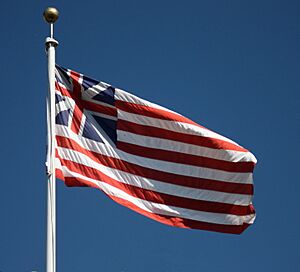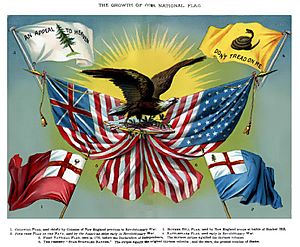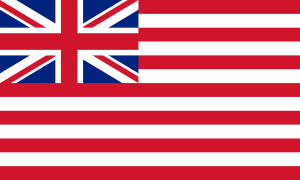Grand Union Flag facts for kids
 |
|
| Names | The Grand Union Flag, Continental Colours, Congress Flag, Cambridge Flag, First Navy Ensign |
|---|---|
| Adopted | 3 December 1775 |
| Relinquished | 14 June 1777 |
| Design | Thirteen horizontal stripes alternating red and white; in the canton, the Flag of Great Britain |
The Grand Union Flag is thought to be the very first national flag of the United States of America. It's also known by other names like the Continental Colours or the Cambridge Flag.
Just like today's U.S. flag, the Grand Union Flag had 13 stripes. These stripes were red and white, one after another. They stood for the Thirteen Colonies that later became the first states. In the top corner, called the canton, was the flag of Great Britain. This showed that the colonies were still connected to Great Britain at that time.
Contents
The First American Flag's Story

By the end of 1775, the American Revolutionary War had begun. The Second Continental Congress was acting like a government for the colonies. They created the Continental Army and the Continental Navy. A new flag was needed to represent these united colonies. This flag had to be different from the flags used by the British.
Before this, each colony often used its own flag. For example, Massachusetts used the Taunton Flag. New York used the George Rex Flag. They needed a flag that brought them all together.
When the Flag Was First Used
Americans first raised the Grand Union Flag on December 3, 1775. This happened on the warship Alfred. It was in the harbor of Philadelphia, Pennsylvania. A naval officer named John Paul Jones raised it. People wrote letters and shared stories about this important event.
The Continental Army used this flag on land and at sea. They used it throughout 1776 and into early 1777.
Who Designed the Flag?
No one knows for sure who designed the Grand Union Flag. But it was easy to make. You could just sew white stripes onto the British Red Ensign flag. Some people say a woman named Margaret Manny was involved with the Alfred flag.
Many people believed that George Washington's army raised this flag on New Year's Day, 1776. This happened at Prospect Hill near Cambridge. Washington's army was surrounding the British forces in Boston. Some British soldiers thought the flag meant the Americans were giving up. But later research suggests this might not be true.
Names for the Flag
The flag has had several names over time. The name "Grand Union Flag" became popular much later. It was first used in the 1800s by a historian named George Henry Preble. He wrote about American flags in 1872.
Similarities to Other Flags
The design of the Grand Union Flag looks a lot like the flag of the British East India Company. This company was very powerful. Some of their flags, used since 1707, were almost the same. They also had stripes and the British flag in the corner. This similarity has led to ideas about where the American flag's design came from.
One idea is that George Washington's army used the Grand Union Flag as a way to protest the British Parliament. But it also showed they were still loyal to King George III. This theory was suggested by a flag expert named Nick Groom.
The Flag Changes
The Grand Union Flag was used until 1777. That year, the Continental Congress passed the Flag Act of 1777. This law created a new official national flag. The new flag was similar but had a big change. Instead of the British flag in the corner, it had 13 white stars on a blue background. These stars stood for the 13 new states.
The law said the stars should be a "new constellation." This meant there were different ways to arrange them. Some flags had stars in a circle. Others had them in rows. The "Bennington flag" even had the number "76" with stars above it.
The British flag in the Grand Union Flag had crosses that showed the union of England and Scotland. The new U.S. flag kept this idea of different parts coming together. This new flag was adopted on June 14, 1777. Today, we celebrate this day as "Flag Day" in the U.S.
The Grand Union Flag in Stories
The Grand Union Flag sometimes appears in books and TV shows that imagine different histories.
- In the book For Want of a Nail, it's the flag of a place called the Confederation of North America. This is a self-governing area created after a different outcome of the American Revolution.
- In The Two Georges by Harry Turtledove and Richard Dreyfuss, it's the flag for the North American Union. It's often called the 'Jack and Stripes'. In this story, some groups change the flag. They replace the British flag in the corner with a bald eagle.
- In the TV show Sliders, an episode shows a world where the American Revolution failed. The Grand Union Flag is used there as the flag of the British States of America. This is a part of the British Empire that is heavily taxed and ruled strictly.




